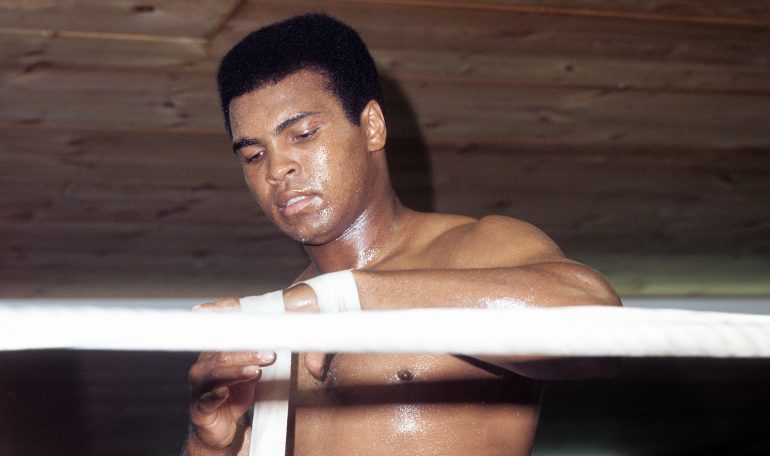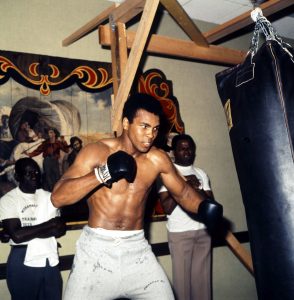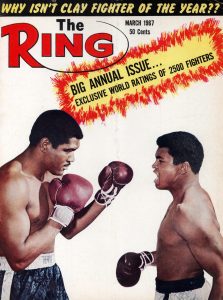Belated justice: Ali named Fighter of Year for 1966 a half century later

Editor’s note: THE RING has named Muhammad Ali Fighter of the Year for 1966 after he was originally denied the honor because of his stance on the Vietnam War and association with the Nation of Islam. Below are articles that will appear in the March 2017 issue of THE RING, the first explaining the current editors’ decision and the second (below the first) a reproduction of the original story explaining the past editors’ decision to deny Ali the award.
Times were different in 1966, when war was raging in Vietnam and many of those back home were demonstrating against the conflict and for civil rights.
Muhammad Ali was in the thick of it all. He had become heavyweight champion by virtue of his victory over Sonny Liston in 1964 and was making headlines for his stance against the war – he was refusing induction – and involvement with the controversial Nation of Islam.
Ali had a big year in the ring, winning all five of his title defenses. That included a third-round knockout of Cleveland Williams, a fight in which many believe Ali was at his very best.
The editors of THE RING Magazine at the time deemed Ali the best fighter of 1966 but they didn’t name him Fighter of the Year because of his activity outside the ring; instead, no one received the honor.
It was only the second such instance; Primo Carnera was denied the honor in 1934 because of his alleged connections to the mob.
These are the criteria by which the editors determined the Fighter of the Year:
- The recipient of the Fighter of the Year prize and RING magazine merit award must be foremost in his contribution to the skill and to the science of boxing. He need not be a champion.
- The Fighter of the Year must combine with his high place in the ranking of boxers a similarly high position as a sportsman.
- The Fighter of the Year must associate with his abilities as a boxer good public relations and a reputation for clean and moral living.
- The Fighter of the Year must be recognized as an example to the Growing American Boy.
And this is how Dan Daniel, the co-founder of the magazine and longtime contributor, explained the editors’ decision in the March 1967 issue of the magazine (see the complete original article on Page xx):
Since 1963 [when he was first honored], Clay has disqualified himself for a repeat award with these demerits:
- Cassius allied himself with the Black Muslims, who avowedly are not friendly toward the United States of America, and are not listed as a patriotic group.
- Clay has entered a protest against his being drafted into the Army, and has laid claim to exemption from service, chiefly on the allegation that he is a student-preacher for the Mohammedan religion.
- The champion boxer of the world has been guilty of utterances which have not redounded to the credit of boxing and which, arousing the vehement protests of the American Legion, Veterans of Foreign Wars and other patriotic organizations, forced cancellation of Clay’s scheduled fight with Ernie Terrell in Chicago, and had other bad repercussions.
The regulations which guide and govern THE RING magazine in its designation of the Fighter of the Year are composed of four paragraphs, the last of which says: “The Fighter of the Year must be recognized as an example to the Growing American Boy.”
Most emphatically is Cassius Clay, of Louisville, KY, not to be held up as an example to the youngsters of the United States.
The decision of the editors might be deemed justified based solely on their policies at the time. They obviously felt strongly that Ali, while succeeding in the ring, didn’t meet the other criteria.
And, frankly, a sizeable segment of society undoubtedly applauded the editors for their stance. “Draft dodgers,” as Ali was labeled by many, were seen as unpatriotic cowards in some circles.

Photo: THE RING Archive
However, we can see the injustice by today’s standards even if we take issue with some of things Ali said and did. Bottom line: He was punished for standing up for his beliefs and his association with a controversial organization, factors that almost certainly wouldn’t preclude a worthy candidate from winning a similar award today.
Ali refused induction in part because of the manner in which African-Americans were treated back home, a sentiment shared by many, and was willing to suffer the consequences – including prison time – if the courts upheld his conviction.
The U.S. Supreme Court ultimately didn’t, reversing a previous appellate ruling by exonerating Ali by a vote of 8-0 in 1971. They deemed him a legitimate conscientious objector, saying his “religious beliefs are founded on the tenets of the Muslim religion as he understands them.”
Of course, that ruling took place after the editors’ decision to deny Ali the award but it’s not too late for us.
And while many took issue with the Nation of Islam – many still do – we feel that athletes under consideration for such awards should be judged by their performance, not their political or religious affiliations. That, we believe, is truly un-American.
We find particularly objectionable one sentence from the original article: “So many fight fans are against Muslim Clay personally that they refuse to see him in a proper fistic perspective.”
Thus, we have decided to right what we believe is a wrong by naming Ali the Fighter of the Year for 1966 retroactively.
“Give it to him,” friend and former rival Larry Holmes said rhetorically when he was told of our decision. “He was the best, wasn’t he? You’re (giving him the award) because he was the best at what he did.
“This has nothing to do with Vietnam, this is boxing. He was the best. You’re rewarding him and giving him credit for that.”
***
NO FIGHTER OF THE YEAR
CLAY’S FINE 1966 RECORD DISCOUNTED BY REFUSAL TO ACCEPT ARMY DRAFT
By Dan Daniel
Editor’s note: This article originally was published in the March 1967 issue of THE RING Magazine to justify the editors’ decision to deny Muhammad Ali the 1966 Fighter of the Year award.
 For the second time since the Fighter of the Year citation was set up by THE RING in 1928, with an award to Gene Tunney, this publication finds it impossible to select a recipient of that high accolade, for 1966.
For the second time since the Fighter of the Year citation was set up by THE RING in 1928, with an award to Gene Tunney, this publication finds it impossible to select a recipient of that high accolade, for 1966.
The precedent for failure to select the Fighter of the Year will be found in the summation of boxing achievements for 1933.
On June 29, 1933, Primo Carnera scored a sixth round knockout over Jack Sharkey and relieved the Boston Tar of the world heavyweight championship.
With a 13-round KO over Ernie Schaaf preceding the success against Sharkey, and a 15-round triumph over Paulino (Uzcudun) following the title acquisition, Carnera appeared to have a clear right fistically to the Fighter of the Year designation.
However, THE RING did not like those who were taking care of Carnera’s business. It did not like the company Primo was keeping and could not, in all conscience and adherence to the regulations governing the Fighter of the Year selection, give the top honor to the heavyweight champion.
Now a similar situation prevents THE RING’s setting up a Fighter of the Year, for 1966.
Strictly on the basis of achievement with his fists, Cassius Clay-Muhammad Ali, heavyweight champion, merits the outstanding citation for the past year.
THE RING gave the Fighter of the Year award to Clay for 1963. Why, then, does this magazine refuse to give it to him again, for 1966, when his fistic performances for the past year outshone those of 1963?
Since 1963, Clay has disqualified himself for a repeat award with these demerits:
- Cassius allied himself with the Black Muslims, who avowedly are not friendly toward the United States of America, and are not listed as a patriotic group.
- Clay has entered a protest against his being drafted into the Army, and has laid claim to exemption from service, chiefly on the allegation that he is a student-preacher for the Mohammedan religion.
- The champion boxer of the world has been guilty of utterances which have not redounded to the credit of boxing and which, arousing the vehement protests of the American Legion, Veterans of Foreign Wars and other patriotic organizations, forced cancellation of Clay’s scheduled fight with Ernie Terrell in Chicago, and had other bad repercussions.
The regulations which guide and govern THE RING magazine in its designation of the Fighter of the Year are composed of four paragraphs, the last of which says: “The Fighter of the Year must be recognized as an example to the Growing American Boy.”
Most emphatically is Cassius Clay, of Louisville, KY, not to be held up as an example to the youngsters of the United States. The regulations covering the annual citation are as follows:
- The recipient of the Fighter of the Year prize and RING magazine merit award must be foremost in his contribution to the skill and to the science of boxing. He need not be a champion.
- The Fighter of the Year must combine with his high place in the ranking of boxers a similarly high position as a sportsman.
- The Fighter of the Year must associate with his abilities as a boxer good public relations and a reputation for clean and moral living.
- The Fighter of the Year must be recognized as an example to the Growing American Boy.
The extra-fistic activities, public utterances and domination by the Black Muslims which have worked against Clay are to be regretted all the more because of the champion’s splendid ring record for 1966.
He marked the year with no fewer than five successful defenses of the heavyweight title.
Muhammad Ali started the year, in March, with his 15 round decision over George Chuvalo in Toronto, and followed with four consecutive knockouts in which he fought a total of only 24 rounds.
Cassius stopped Henry Cooper in six in London; Brian London in three, again in the capital city of Britain; Karl Mildenberger in 12 in Frankfurt; and Cleveland Williams in three in Houston, Tex.
The fight with Williams marked Clay’s first appearance in the United States since November 22, 1965, when he stopped Floyd Patterson in 12 rounds in Las Vegas.
But for the circumstances which prevented Clay’s designation as the Fighter of the Year his five victories would have been hailed as splendid highlights of a big heavyweight twelvemonth, reflecting tremendous credit on the sport and locating Cassius in the fistic niche in which he properly belongs.
As it is, Muhammad Ali fails of recognition not only as the Fighter of the Year but as a member of the all-time heavyweight aristocracy. So many fight fans are against Muslim Clay personally that they refuse to see him in a proper fistic perspective.
With Clay completely out of the Fighter of the Year situation, we find Dick Tiger the No. 1 man of 1966.
Dick dropped out of the elite corps when he lost the middleweight championship to Emile Griffith, the decision a close one. But the Nigerian rehabilitated himself with a smashing victory over Jose Torres, for the light heavyweight title.
In moving into the light heavyweight division and gaining its leadership, Tiger duplicated the feat of Griffith, who quit the welter class to make a successful foray in the ranks of the middleweights.
It was between Tiger and Griffith for the 1966 spotlight, and the Nigerian got the nod for a more emphatic triumph.
The No. 3 man in the 1966 list of highlighted boxers is Carlos Ortiz, lightweight champion, who clinched that position with a five round stoppage of Sugar Ramos in Mexico City, referee Billy Conn halting the fight, and a near-shutout victory over Flash Elorde in New York. The man from the Philippines was knocked cold, in the fourteenth round.
The No. 4 spot belongs to Curtis Cokes, who clinched his right to the vacant welter title by outpointing Jean Josselin, of France, in a tough fifteen rounder in Dallas.
The No. 5 entry on the standout list is Vincente Saldivar, featherweight champion, who had only two fights during 1966 but made good on both occasions.
A summation of the feats listed for the various accredited rivals for the 1966 spotlight made Clay’s fistic leadership all the more emphatic.
But Cassius would not stand up for that leadership. He saw fit to repudiate it, an act without precedent in the history of the heavyweight class since it abandoned bare knuckles and put on gloves.
















